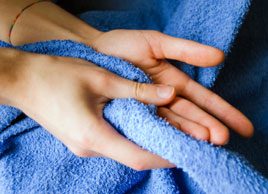The best ways to wipe out germs at home
Avoid cold and flu season with these home cleaning strategies that can help keep germs at bay

Source: Best Health Magazine, December 2011
When someone in your household gets sick, a top-of-mind concern is how to keep the germs from getting passed around to other family members. Cold and flu germs are easily transferred by hands, so front-line strategies for controlling contagion include washing your hands often, coughing and sneezing into a sleeve or a tissue, as well as getting a flu shot.
But household cleaning can also make a difference. "We don’t need to sterilize our homes; we just need to keep them clean," says Dr. Camille Lemieux, associate director of the University Health Network’s Infection Prevention and Control Unit in Toronto. "It’s the physical cleaning that tends to get rid of enough of the organisms to make our homes safe."
Indeed, Health Canada warns against using products in the home that are labelled "antibacterial," "antimicrobial" or "bacteria-fighting," which contain chemicals, typically benzalkonium chloride or triclosan, to kill common bacteria and viruses. These chemicals may also wipe out the friendly bacteria we need to fight germs and stay healthy. Plus, many health experts and agencies warn that these products can lead to a rise in bacteria that are resistant to antibiotics. (However, products with antibacterial chemicals may be recommended in institutional settings such as hospitals, where traffic is high and the volume of germs on surfaces can be greater.)
So, what works best at home? Plain water certainly won’t suffice. That’s because water and oils naturally repel each other, so when germ particles stick to grease on surfaces, it’s hard to pick them up with water alone. However, any cleaning product that contains a surfactant ‘ detergent or other substance that decreases the water’s surface tension ‘ will soak up dirt and oils, removing the germs we don’t want. It’s the same concept as using soap when you wash your hands.
Products that contain hydrogen peroxide or bleach can kill or inactivate viruses found in the home. Those products labelled "disinfectant" will also inactivate disease-causing bacteria and viruses, and they don’t necessarily contain the antibacterial chemicals that health experts recommend avoiding.
To do the job, keep these tips in mind:
‘ Apply enough product to wet the entire surface
That means if you’re using a spray bottle, make sure you aren’t leaving dry spots as you’re spritzing. If you’re pouring a cleaner onto a cloth or directly onto the surface you’re cleaning, it doesn’t make a difference whether it’s liquid, cream or foam as long as the surface is saturated and the dirt and debris gets wiped away. If using pre-moistened cleaning wipes, close the lid tightly once you’ve finished cleaning; the wipes can dry out.
‘ Put some muscle into it
"Rather than wiping lightly as if you’re dusting, you need to use a little bit of elbow grease," says Dr. Judy MacDonald, medical officer of health for Alberta Health Services in Calgary.
‘ Choose a good cloth
Don’t clean with the same rag you washed the dishes with; that can spread contamination from one area to another. And be sure to launder all reusable cloths in hot water between cleaning sessions. Consider buying microfibre cloths, which are made up of extra-tiny strands, creating lots of surfaces and spaces in the cloth to pick up germs. Explains Lemieux: "It has been shown in studies that washable microfibre cloths are better for cleaning than your standard rag or paper towel because of their huge surface area."
How often should you be scrubbing when a family member comes home sick? It’s a good idea to do a thorough cleaning of all surfaces that get sneezed or coughed on, that are frequently touched, or that are touched by multiple people. You can then do spot-cleaning as needed.
This article was originally titled "Wipe out germs at home" in the December 2011 issue of Best Health. Subscribe today to get the full Best Health experience’and never miss an issue!




